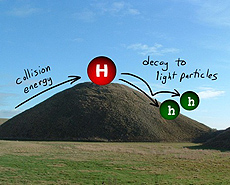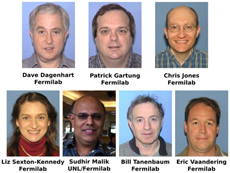|
Friday, Dec. 14
3:30 p.m.
DIRECTOR'S COFFEE BREAK - 2nd Flr X-Over
4 p.m.
Joint Experimental-Theoretical Physics Seminar - One West
Speakers: Steve Brice, Fermilab
Title: The Neutrino Program at Fermilab
Monday, Dec. 17
THERE WILL BE NO PARTICLE ASTROPHYSICS SEMINAR THIS WEEK
3:30 p.m.
DIRECTOR'S COFFEE BREAK - 2nd Flr X-Over
THERE WILL BE NO ALL EXPERIMENTERS' MEETING THIS WEEK
Click here for NALCAL,
a weekly calendar with links to additional information.
Ongoing and upcoming conferences at Fermilab |
|
Friday, Dec. 14
- Breakfast: blueberry-stuffed French toast
- Cuban black bean soup
- Grilled portobello sandwich
- Southern chicken and biscuits
- Smart cuisine: Greek fish florentine
- Baked ham and Swiss ciabatta
- Assorted pizza
- Malaysian curried chicken
Wilson Hall Cafe Menu
|
|
Friday, Dec. 14
Dinner
Guest chef: Marty Murphy
- Spinach and pomegranate salad
- Surf and turf
- Vegetable risotto
- Cheesecake a la Marty
Wednesday, Dec. 19
Lunch
- Pork tenderloin with brandy cream sauce
- Sweet potatoes
- Sautéed green beans
- Assortment of Christmas cookies
Chez Leon Menu
Call x3524 to make your reservation.
|
|
Explain it in 60 seconds:
decay channel
 |
When particles decay, they transform into lighter particles. Physicists can predict how often a particle will decay into certain end products. Image: Sandbox Studio
|
Decay channels are the possible transformations a particle can undergo as it decays.
When a particle decays, it does not break into smaller bits; its energy does. Even fundamental particles—so named because they are the basic building blocks of matter that cannot be broken into smaller parts—can decay. Many particles in the Standard Model exist for only a limited time before decaying.
When a particle decays, it transforms into collections of less massive particles whose combined energy adds up to the energy of the original particle.
It's kind of like getting change for a dollar. Even though a dollar bill is not physically made of coins, its value can be broken down into change. And just as many different combinations of coins add up to $1, many combinations of particles can add up to the energy of a massive particle. Each one of those particle combinations is called a decay channel.
Physicists can calculate how long a particle should last and the ways it should decay. Knowing a particle's decay channels can help physicists spot a massive particle created in a particle collider, even if the particle decays before a detector can capture it. If experimentalists can't see the particle itself, they can see the products of its decay.
—Kathryn Jepsen
Read similar explanations in the symmetry archive
|
Higgs boson discovery, MINERvA make Physics World breakthrough list of 2012
Physics World, published by the Institute of Physics, has chosen the discovery of the Higgs boson and an experiment using the MINERvA detector at Fermilab as two of its top 10 breakthroughs of 2012.
A boson likely to be the Higgs was discovered by the ATLAS and CMS experiments at the LHC. Read media highlights on the Higgs discovery.
An experiment using the MINERvA detector, proposed by an engineer at North Carolina State University, successfully transmitted a message using neutrinos. You can read more about the experiment in this symmetry article.
Read the Physics World citations.
|
January wellness offerings, fitness classes and discounts
Wellness offerings include free weight management and QiGong/Tai Chi Easy classes, fitness classes and employee discount information for January.
Wellness classes:
An Honest Approach to Weight Management
Thursdays, Jan. 10 to March 28, noon to 1 p.m., Wilson Hall Curia II.
Register by Dec. 21.
Weekly Qi Gong, Mindfulness and Tai Chi Easy for Stress Reduction
Wednesdays, 7 to 8 a.m., and Fridays, noon to 12:45 p.m., Ramsey Auditorium.
Fitness classes:
Butts & Guts
Mondays, Jan. 7 to Feb. 25 (no class Jan. 21), noon to 12:45 p.m., Fitness Center
$52/person
Wednesdays, Jan. 9 to Feb. 27, noon to 12:45 p.m., Fitness Center
$58/person
Kyuki-do
Mondays and Wednesdays, Jan. 7 to Feb. 13, 5 to 6 p.m., Fitness Center
$60/person
Yoga
Tuesdays, Jan. 8 to Feb. 26, noon to 1 p.m., Fitness Center
$90/person
Zumba
Tuesdays, Jan. 8 to Feb. 26, noon to 12:45 p.m., Fitness Center
$50/person
Fridays, Jan. 11 to March 1, noon to 12:45 p.m., Fitness Center
$50/person
Employee discounts:
AMC and Regal movie tickets
Changarro Restaurant
BatteriesPlus
Rosati's of Batavia
Dragon II Restaurant
For more information, contact Jeanne Ecker in the Wellness Office at x2548 or at jecker@fnal.gov.
|
Hubble Space Telescope achieves deepest cosmic view yet
From BBC News, Dec. 12, 2012
Hubble astronomers have observed deeper into space than ever before.
In doing so, they have identified six new galaxies of stars that formed just a few hundred million years after the Big Bang itself.
The study also updates a distance estimate for a seventh galaxy, placing it further back in time than any object previously identified.
Read more |
|
Hidden valleys in our own backyard
 |
| High-energy collisions may reveal new lightweight particles if they are decay products of a heavy one. |
To search for new phenomena, physicists need to go where no one has gone before. High-energy collisions have the potential to create particles too heavy to have been made in previous experiments at lower energy since the masses of the new particles come from the energy of collisions. High beam intensities shine more light on rare processes because a larger number of collisions means more chances to see an improbable reaction or decay. Sometimes, though, you need a little of both.
Suppose that there's not just one new particle waiting to be discovered, but a whole system of new particles. Some of these may be hidden by their high masses while others may be hidden by very low reaction rates with ordinary matter. This possibility is sometimes called a hidden valley. If we can reach high enough in energy to create one of these new massive particles, it can decay into all the rest, revealing the whole landscape.
To test such a scenario, CMS scientists looked for new particles in their own backyard. That is, they scanned the debris of high-energy collisions for signs of low-mass particles to see if any new ones had slipped in among the familiar faces of the 1960s particle zoo. This is different from most searches, which look for high-mass signatures directly.
To be concrete, these scientists posed the question: what if the Higgs boson is not a single particle, but a family of interrelated particles? In addition to directly observing a new massive boson, like the one discovered last July, they should see the lightweight cousins of the Higgs from Higgs-to-Higgs decays. Or alternatively, what if dark matter has its own version of a photon, oxymoronically known as dark light? These dark photons would be produced along with invisible dark matter, but they would appear as visible low-mass particles.
In a careful analysis, no new lightweight particles were found. But when searching for the unexpected, it's important to keep the whole landscape in view, including the part we thought we knew.
—Jim Pivarski
 |
| The physicists shown above developed and performed this search for new low-mass particles. |
 |
| The efforts of the Fermilab LPC User Support Group are crucial and enable many CMS physics analyses. |
|
Higgs boson having an identity crisis
From New Scientist, Dec. 13, 2012
The Higgs boson is sending mixed signals: its mass seems to vary depending on how it is measured. What's more, oddities in the way it decays into other particles, first noticed when the team at the Large Hadron Collider announced the discovery of a new boson in July, do not seem to be going away.
Experiments at the LHC, part of the CERN particle physics laboratory near Geneva, Switzerland, do not detect the Higgs directly. Instead, they collect and analyse the slew of particles it is predicted to decay into. The latest results from the ATLAS detector at the LHC suggest that when we look at its decay into two photons, we find that the new boson's mass is about 3 GeV greater than when calculated from its decay into particles called Z bosons.
Read more |
|




